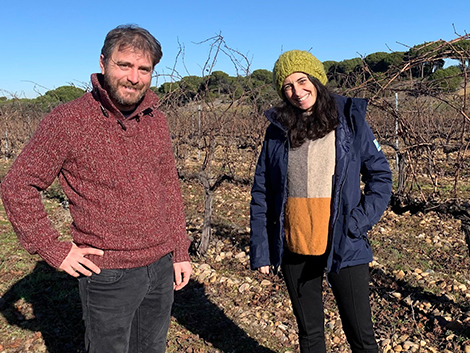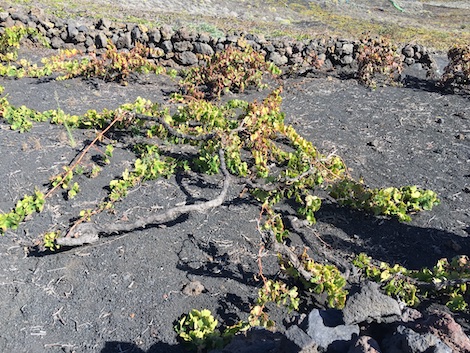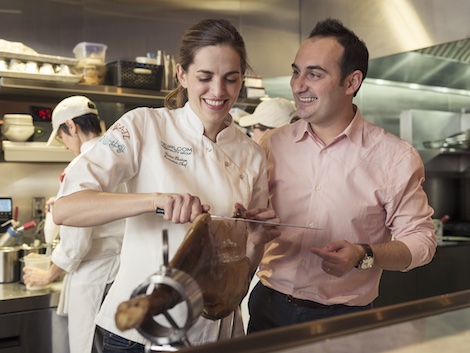
It is not easy to be a small player in Rueda. The first Barco del Corneta wine was produced in 2010 but the winery was not formally established until 2013. At the time, production stood below 30,000 bottles so, according to the rules of the DO, it didn’t qualify to be a member. Nowadays, Barco del Corneta not only exceeds this requirement, but its goal is to reach 100,000 bottles in the near future. Being an independent player just suits its needs better.
Barco del Corneta is the name of the pine forest that lies next to the 5.5Ha vineyard that winemaker Beatriz Herranz and her mother María Antonia Sanz planted in 2008 in Cantarranas, a lieu-dit in La Seca. They used Verdejo cuttings from an old plot in the village. As well as enhancing biodiversity, pine trees partially isolate the vineyard and lend it a wild and secluded feel amidst the landscape of broad horizons and undulating terrain that dominates in La Seca and other villages in this part of the Duero River Valley in the heart of Castilla y León.
The site, where vines had not been grown for some time, was inherited from Beatriz's grandfather. Beatriz was born and raised in Valladolid, but this vineyard has helped her to reconnect with the village of her ancestors and the land they cultivated.
Her first intention was to sell the grapes, but in 2010 she decided to have a go at vinifying 500 kg in the winery where she worked in Gredos at the time. She simply crushed the grapes from her very young vineyard and left it to ferment in a second-year barrel. The outcome was really interesting and very different from the strident aromatics that prevailed in most market-driven Verdejos of the time.
Vineyard and winery in sync
The quality of Barco del Corneta 2018, its current vintage, shows that excellent Verdejo can be made from relatively young, trellised vineyards (the vines were 10 years old in 2018) when planted on suitable soils and farmed to yield top quality grapes.
From the very beginning Beatriz wanted it to be a dry-farmed, organic vineyard with moderate yields (the record is 7,000 kg/ha in the highly productive 2016 vintage, but the average is close to 5,000 kg). She was also convinced that Verdejo was a fine grape variety suitable to be aged in oak.
Time is certainly on its side. Beyond the fresh nature of the 2018 vintage, the wine has gained depth and complexity in the bottle to offer a lovely combination of floral, toasted nuances (sunflowers seeds) and a hint of petrol. On the palate it is juicy and vibrant -definitely a wine with plenty of life ahead.
The arrival of Félix Crespo as a partner in 2016 contributed to strengthen the venture. A former university colleague, Crespo brings unvaluable experience from his time at Belondrade in La Seca, the benchmark producer for oak-aged whites in the area. Another boost to the project is the new winery, where they vinify since 2019. It occupies the old apothecary's shop of La Seca which, like most manor houses in the village, had its own cellar. Beatriz and Félix renovated its old buildings to suit their needs.
The old stables, the henhouse and the tool storage area were converted into a wine fermenting area while the tasting room stands above the old wine press. Part of the building is now the home of Beatriz, and the spacious courtyard has proved extremely useful at harvest time. Interestingly, there are two underground cellars with perfect conditions to age the wines and to store bottles of past vintages. Despite the youth of Barco del Corneta, Beatriz and Félix are positive that their wines improve considerably after spending some time in bottle.
In pursuit of balance
The range of wines is designed from the land. The Barco del Corneta vineyard features three different types of soils: sand on the lower part near the pine forest, gravel on the central area and clay on the upper section. Vines grown on gravel, which are the first to ripen, go almost entirely to Barco del Corneta.
Frost and very low yields marked the 2017 harvest, but it also provided valuable wine growing lessons. "The highest area avoided the frost, but the sandy, lower part was badly hit. After that, we started to do long prunings, which we adjust later in mid-April. As a result, we are able to moderate vigour and slow down the plants’ cycle on sandy areas to have a staggered harvest," they explain. The six days it takes to harvest the entire vineyard by hand is indicative of the detail they apply to their work.
The key factor in the vineyard is balance, the pair agrees. Thus, despite the very low yields of 2017, when an excess of concentration meant extremely small berries in the area, Beatriz and Félix managed to pick bigger fruit than the average.
Grapes destined to Barco del Corneta (around €17 in Spain) are fermented and aged in 300-, 500- and 600-litre oak casks. As for Cucú (€9.50), the regional white that blends grapes from La Seca (Valladolid) and Aldeanueva del Codonal (Segovia), only 30% is aged in oak. The batches from Segovia are put in seasoned barrels given that they are sourced from young vineyards. Located at higher altitude, the Segovia vineyards bring plenty of freshness to match the full-bodied grapes grown in La Seca. The result is a tasty Verdejo with light floral notes that provides a good introduction to Rueda's flagship grape variety grown with a low-intervention approach.
Both wines are organic and feature cheerful, eye-catching and colourful labels. A paper boat has been the identifying element of the Barco del Corneta label since the first (barco means boat in Spanish). The design has been progressively refined over time (you can see the evolution in the slider above), but it arguably feels a bit naïve for the increasingly complex wine that lies behind.
A tribute to old vineyards
The premium range includes three wines made from the area’s three main white grape varieties: Verdejo, of course, but also Viura and Palomino. Production in all cases stands below 2,000 bottles. The trilogy is called Los Parajes del Infierno. Winemaking remains more or less the same: natural fermentations and ageing in large oak casks often followed by a few months in stainless steel tanks prior to bottling. When possible, malolactic fermentation is avoided, but that’s not always easy: working with natural yeasts usually involves longer alcoholic fermentations.
Most of the grapes in Parajes del Infierno are sourced from Alcazarén, a village in the Valladolid province about 30 km east of La Seca. They are grown in small plots totalling 1.5 ha, all close to each other, with 100-year-old, ungrafted, phylloxera-free vines planted on sandy soils, described by Beatriz as “beach sand.” This is the source of La Sillería, a Verdejo that was originally released under the brand Casio, and Las Envidias (€22 in Spain), a Palomino formerly called Bruto. Inspired by Jerez, the Spanish region where this grape variety thrives, Las Envidias is aged under a veil of yeasts (flor).
Only vineyards this old can bring about the level of refinement and depth of La Sillería (€27). The current 2019 vintage still feels very young: vibrant, marked by citrus notes and showing amazing potential. It is not unreasonable to say that it will provide enjoyment for at least 10 years. I was certainly impressed by the length of the barrel samples I tasted during my visit.
Judas (€25) is Barco del Corneta’s take on Viura, a variety that has reached new heights in Rioja. There is also an emotional bond, given that this was the grape grown by Beatriz’s grandfather in a site called Paraje del Infierno (hence the name of the trilogy) in La Seca. In this case, grapes are sourced from Villanueva de Duero (Valladolid), a 15-minute drive north of La Seca. All these villages are part of Tierra de Pinares, a region with distinctive sandy soils named after the abundance of pine forests.
In Villanueva, sand is more dominant than in La Seca and gravel stones are bigger. The vineyard destined to Judas was planted in the late 1960s. There’s a creamy note in the wine and, as it happens with Viura in Rioja, some bottle ageing is needed for wine and oak to be fully integrated. The 2015 vintage from Barco del Corneta’s library collection that I tasted had developed a compelling maturity with toasted nuances, beeswax hints and good weight on the palate.
At present, varietal Palomino or Viura wines are not allowed under the seal of DO Rueda, but perhaps the most worrying issue in the area is the loss of traditional vineyards. In contrast with the significant surface growth in the first two decades of the 21st century, Beatriz and Félix fear that “the recent ban on new plantings will lead to the uprooting of the remaining goblet-trained vines.” In La Seca, a flagship village of Rueda, only 313 out of almost 3,600 hectares are bush vines.
Barco del Corneta also produces the red Prapetisco from grapes grown in Arribes, further west. Click here for more details.

Amaya Cervera
A wine journalist with almost 30 years' experience, she is the founder of the award-winning Spanish Wine Lover website. In 2023, she won the National Gastronomy Award for Gastronomic Communication
NEWSLETTER
Join our community of Spanish wine lovers






